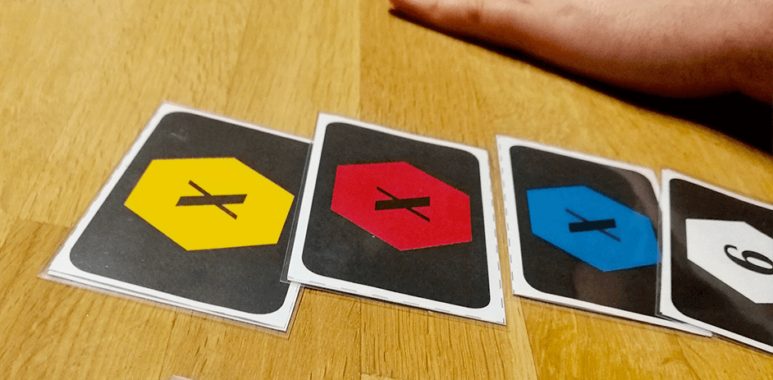
SPICY – Development Insights
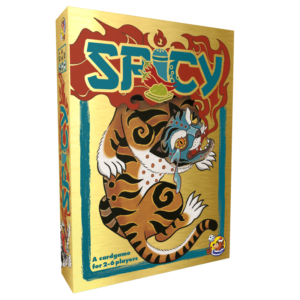 Our bluffing game Spicy stands out not least because of its simple rules. Our HeidelBÄR Games´ game developer Roland describes the process behind this seemingly simple concept.
Our bluffing game Spicy stands out not least because of its simple rules. Our HeidelBÄR Games´ game developer Roland describes the process behind this seemingly simple concept.
Note, rules, theme and graphics have changed several times during the development, so don’t let yourself be confused. 😉
First contact: Multiplied tension
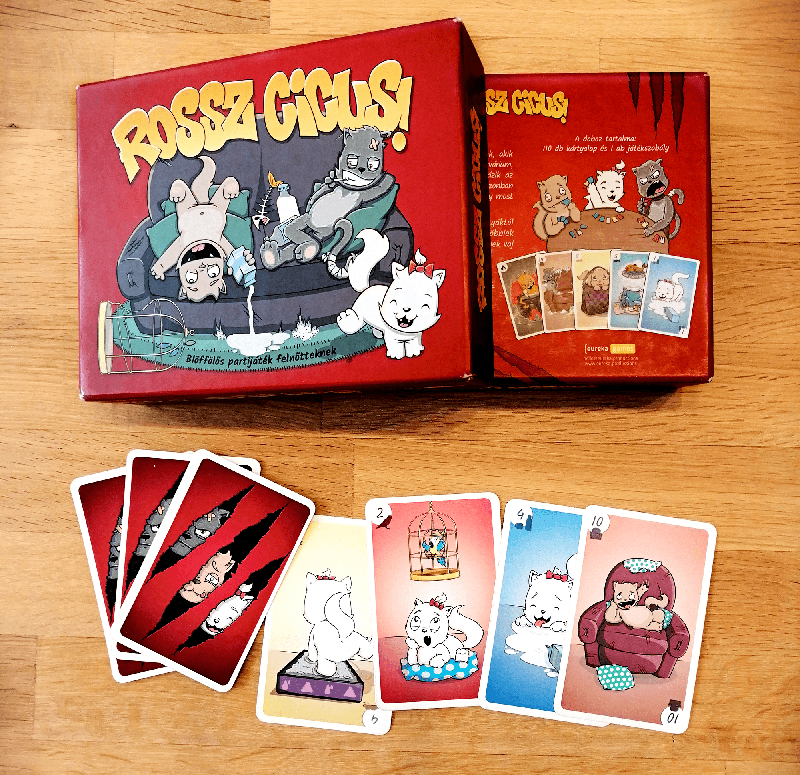
In 2017 at the annual SPIEL convention in Essen, my colleague Sabine and I had an appointment with our old partner and friend Zoltán Aczél from the Hungarian publisher Gém Klub. Zoltán showed us an already finished prototype with the title “Rossz Cicus!” (Bad Kitty!). After the explanation I thought: This I already know! A schoolyard classic known by various names: Bullshit, Cheat, I Doubt It, Lies, Cheating, etc. Nevertheless, we started playing. At the first challenge, I felt a strange, new, stronger emotion than with the cheating classics – I had to announce what’s wrong: color or number? The tension didn’t disappear with the calling of a lie. Indeed the moment of doubt became stronger on both sides. On one side: What do I doubt? On the other side: What if I fall for a half-truth? Apart from that element, the game was very simple: five suits with numbers from 1 to 14, each card appearing once and with the main objectives being to get rid of all cards and receive as few penalty cards as possible. I really wanted to take it with me and work on it.
First frustration and research
After tests in various pubs and with my children, I was quite frustrated. With five suits, the last card usually turned out to be the wrong spice. With anxious players, the card pile in the middle grew fast, which made them even more anxious. Those who took a big minus pile were frustrated and hopelessly behind. The middle ranks felt meaningless – yet there was still this moment of doubt after you had announced that something was wrong: suit or number?
I wondered whether the question “Correct suit or number?” had been asked in other bluff games. It’s so simple, so seemingly compelling. I went through the bluffing category on www.boardgamegeek.com, browsed Hugo Kastner’s Kartenspiel-Enzyklopädie (a German card game encyclopedia), and skimmed various books in our archives. Nothing was exactly like that. The closest game that came to the idea was Mammuz from Hobby World, a game in which you claim to play several cards of the same type with the challenger only revealing only part of them, but I was not sure. In 2018, I took the prototype to the Hippodice competition and played it with eight other editors in the evening. No one was familiar with this concept of the half-lie, but I sensed that they liked it, which encouraged me to push the game release by all means.

First variations

We tested additional chips that could be used to change the number or suit of a card. It was way too brain-locked. Then came the wild cards: We didn’t want to have wild cards that were always right like in Uno or MauMau. You should always keep a certain amount of risk. We tried it with two suits without numbers or four numbers without suit. They were too weak.
The first real progress was the reduction to three suits and numbers from 1 to 10. Thus the suit of the last card was wrong in only two of three cases – and probably less if you had started the round yourself. With three suits and numbers from 1 to 10, we could triple the quantity of each card, which made memorizing superfluous.
A second advance was the introduction of trophies for the successful playing of your final card in hand. These trophies prolonged the game, and the game end did not seem so random anymore. At that time, there were more than 3 throphies with ascending values.
With this set-up, we played the game again with Zoltán at Spielwarenmesse 2018, with Zoltán being our middleman to the author, Zoltán Győri, a. k. a. the second Zoltán.
Superpowers (A.K.A. spice it up cards)
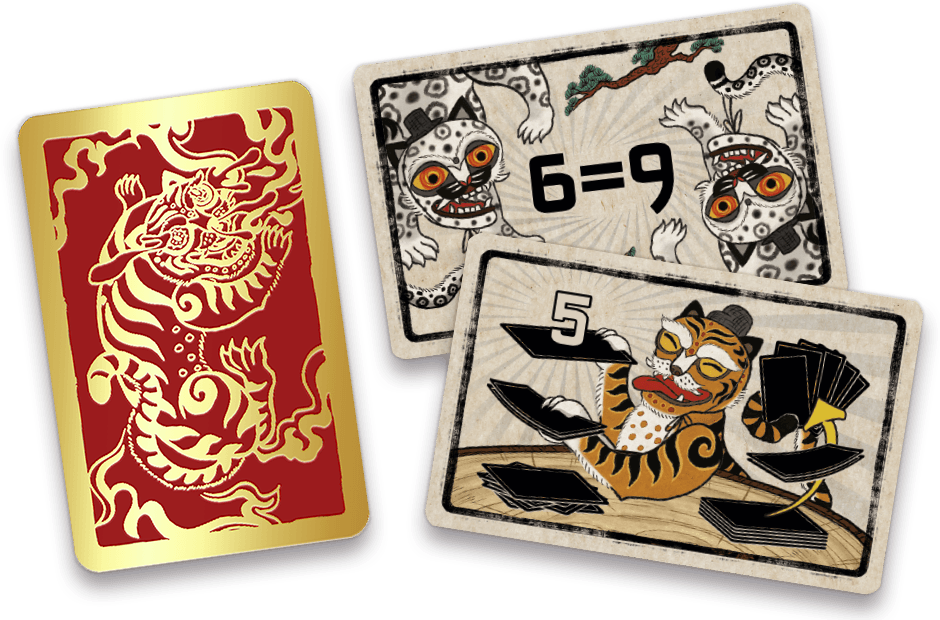
Zoltán Győri’s original game contains special cards and special effects. We wanted to have these “superpowers” in the game, too, but just as an addition.
Only the Copy Cat — which allows you to play the same card as the previous player — was integrated in the basic game for a long time because it creates wonderful moments and for larger rounds, it ensures a constant participation of everyone. The important thing was that it had to be riskier than a normal announcement because otherwise you could constantly jump in with half-lies, and chaos arose, but it was exactly this different kind of challenge that always caused confusion and mistakes by newbies, which is why we finally removed it from the basic game.
Unsolved problems and a surprisingly positive winter turnaround
We tried to cancel the frustratingly large minus point piles through the use of positive points for correctly announced challenges, either in the form of chips or by allowing you to throw away penalty cards. But this never felt right, and the game could still run dead if nobody wanted to risk a challenge, which meant the minus pile would just become bigger and bigger.
In the winter of 2018/19, the fine-tuning was about to start. The Zoltáns tested intensively, especially the superpowers. There were tests with a single superpower for everyone, and tests with special superpowers that only one player could use; tests with positive special effects such as Copy Cat, and tests with handicaps in which the player of a card had to be declared a “man of honor” or “honor taken” to avoid a penalty. The handicaps often caused laughter but were too silly for all of us in the end.
Even worse still was that in the Zoltáns’ test groups of pro-players, the game kept getting stuck on large piles — and the game got fun again only when one player sacrificed themselves.
Then our long-term intern Christoph had an idea during another round of bluff in a Bürgstädter Heckenwirtschaft, which is a local tavern with restricted seasonal opening: “Let’s try the game with positive points!” A quick test worked. Not only was the angst gone, but we could also simply turn any cards left over in your hand at game’s end into negative points. The problem that had caused us to search for additional positive incentives vanished into thin air. After one week, the new rule was ready, the superpowers were adjusted, and we waited for feedback from Hungary. It was, as hoped, pleasantly positive. The only small flaw was and still is that the (negative) emotions are much stronger when you collect negative cards than when you collect a few positive cards — but creating an overall positive mood is much more important.
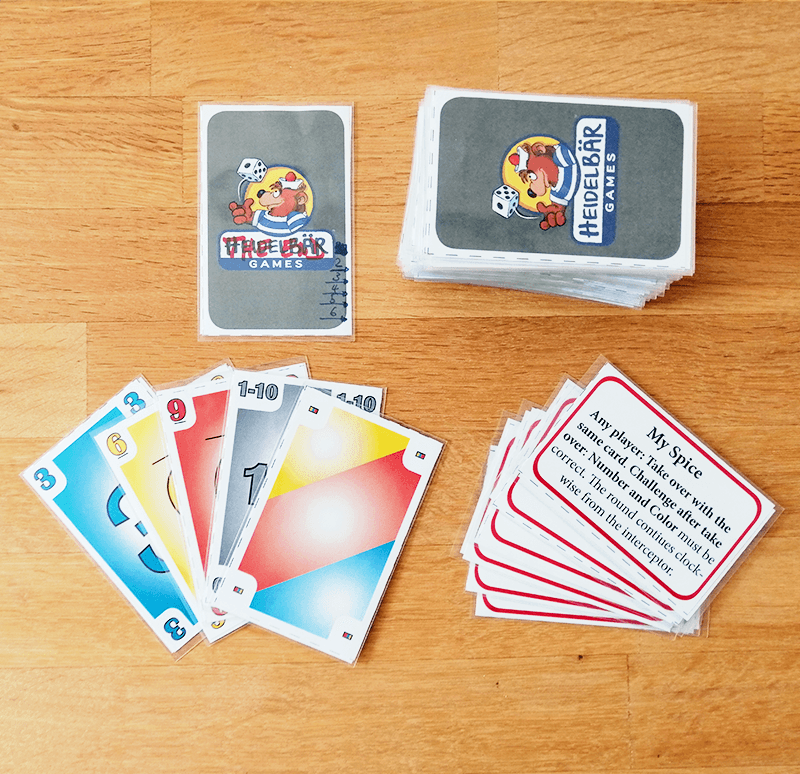
Along the way, the punishment for the loser of a challenge got much easier and was compensated with a bonus: The challenge loser draws two cards (which are minus points while in hand), then starts the next pile. Thus, the former loser can get rid of one card right away and can also choose the suit of the next pile, which is very strong.
In retrospect, I can only wonder why it took us so long to find this positive twist for such a little bluffing game.
No elimination for long-lasting tension
Many well-known and successful bluff games use player elimination down to the last man: Bluff, Coup, Poker, Werewolves, or Skull. When a bluff game is all about survival, players often make passive announcements and just hope that someone else is caught. The bigger the round, the more pronounced this behavior is.
We are very happy to have found a way for Spicy that creates enough tension without player elimination. Often the game is not decided until the final trophy. Apart from the trophies, you can score points only if you actively doubt correctly or lure another player into a trap. Both of these actions are possible only when it’s your turn, which is why we allow anyone to doubt at any time (and if you play with Copy Cat, even to make an announcement at any time). This must be combined with a risk (in case of an announcement that breaks the player order with an increased risk), so that the game does not collapse. I am proud of how these rewards, punishments, and risks work together in Spicy and I am glad that Heiko gave Spicy the time to mature.
The World´s End Card
From the beginning, the game ended in one of two ways: One player gets rid of their cards, or the deck is empty. We had replaced the former condition with several trophies being in play, with three trophies working best as winning the game with two trophies felt really huge.
Ending the game via an empty deck unfortunately sometimes led to tactical doubting and to small extra rules for who had to draw which cards at the end.

The typical shuffling in of a “game end” card was too uncontrolled as it led to games that felt too short or too long. I then remembered Tiefe Taschen by Fabian Zimmermann, which we had tested intensively in Heidelberger times. I asked him about the authorship of that game’s ending condition, and he told me: “An editor showed to me during a game set-up at the game designer convention Autorentreffen in Göttingen how he does it at home: ‘Just slide it in!'”
In the final game, you slide the “game end” card at an approximate height based on the number of players. You all have an idea of when the game will end, but cannot know for sure.
Gold
For many years, Heiko has been an fan of Coup, the successful bluffing card game by our old partner Indie Boards & Cards. This is one of the reasons why he was critical of the concept of Spicy for a long time as Coup attracted him more. Not only the bluffing but also the silver box fascinated him — yet the path from silver to gold was not a difficult one.
Theme selection
For a long time, my favorite theme was “Chuck”, based on various “facts” about Chuck Norris: A few wannabe daredevils meet for a wooden board, brick, anything else smashing contest: I finish “3 boards”, I break “7 boards”, and the 10 is Chuck because “Chuck finishes all”, and then the claims have to start all over again. After the challenge, the loser gets all the junk in front of their hut.

With the new, positive game experience, the search for a fitting theme and the development of the graphics went into a new round. The brainstorming led us from fire-breathing dragons, strange unicorns, etc. finally to cats once more, which pleased the Zoltáns as they had cheered from the beginning for “Bad Kitties”. Heiko and Marina were on fire for big cats in combination with traditional Asian cat pictures. Our Korean partner Thomas arranged the contact to Jimin Kim, an artist from Busan, who at first could not believe we wanted a bunch of crazy twisted cats on our golden box. In the end, the big cats found their fans, there is even a special special thread on BGG for the Spicy illustrations.
Learn to lie?
Bluffing games are a controversial genre, but Heiko and I have enjoyed them for a long time. Bluff has accompanied me for decades. You can play Spicy as soon as you can hold a hand of cards, count to ten, and mischievously lie, so five years and up is fine. But beware: I have experienced some educators who refused Spicy outrageously, especially for children because it would teach them to lie. I think that’s nonsense. To me, acting, tricks, probabilities, trash talk, and the assessing of gestures are wonderful at any age, especially if you can laugh as much as you can with Spicy. To take freely from Nietzsche: “He who cannot lie doesn’t know what playing is.”

